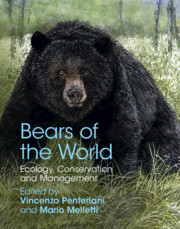Book contents
- Bears of the World
- Bears of the World
- Copyright page
- Dedication
- Frontispiece
- Contents
- Contributors
- Foreword
- Acknowledgments
- Introduction
- Part I Systematics, Ecology, and Behavior
- Part II Species Accounts
- Part III Human–Bear Coexistence
- Part IV Conservation and ManagementConservation and Management
- Index
- Miscellaneous Endmatter
- Plate Section (PDF Only)
- References
Part I - Systematics, Ecology, and Behavior
Published online by Cambridge University Press: 16 November 2020
- Bears of the World
- Bears of the World
- Copyright page
- Dedication
- Frontispiece
- Contents
- Contributors
- Foreword
- Acknowledgments
- Introduction
- Part I Systematics, Ecology, and Behavior
- Part II Species Accounts
- Part III Human–Bear Coexistence
- Part IV Conservation and ManagementConservation and Management
- Index
- Miscellaneous Endmatter
- Plate Section (PDF Only)
- References
- Type
- Chapter
- Information
- Bears of the WorldEcology, Conservation and Management, pp. 3 - 62Publisher: Cambridge University PressPrint publication year: 2020

